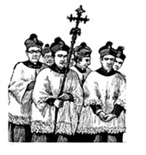
Does Good Liturgy Beget Moral Virtue?
A BOOK CRITIC’S IMPRESSIONS OF A LIVING CLASSIC
One scorching Corpus Christi in the first decade of this millennium, as an occasional book critic with a little time on my hands, I checked out the Traditional Latin Mass (TLM) that had been recently imported from France into my violent American city. I entered a surprisingly crowded but spookily silent neo-Gothic church that had been marked for demolition until the French order of priests took it over. It wasn’t hard to find: the steeple was 300 feet high. The gilded 52-foot-high reredos and a 40-foot-wide carved altar rail would have dropped Attila the Hun to his knees. Cassocks and fiddleback chasubles were back, auricular-only confession lines jammed, genuflections and signs of the cross abundant, brown scapulars visible, long dresses and covered shoulders de rigueur, fasting obvious, and fertility robust.
Even though I taught Latin at a classical school, I couldn’t keep up with the intoned rises and falls. No worry, a priest said later, I wasn’t talking to you. Procession and benediction around a decrepit inner-city block left thousands of rose petals on potholed streets. I didn’t get loose for three hours and felt that I had fallen in and out of an artistic and sartorial time warp. Thinking as a book critic, I suspected, even at first glance, that this blast from the past portended more than a restoration in liturgy alone.
I was in the presence of a living classic.
Two movements were slowly trending together in this diocese. Month after month, year after year, the suburban pews in Pizza Hut pagodas purged themselves of polo shirts and Bermuda shorts, of music ministries imitating the 1970s pop group Tony Orlando and Dawn, and of jolly priests roaming the pews with mics like local reporters at a ribs festival. Meanwhile, this German-crafted church was filling with young faces behind fine-lace veils and shoulders-back pressed suits. Inside a nave 130 feet long and 70 feet high, congregants said they were drawn by a more fitting beauty, and they professed piety and virtue with the example of their lives. What do they mean, why are their many children so well behaved, and why do they have their stuff so manifestly together?
You May Also Enjoy
The Vatican has decided to draft a new "instruction," necessitated by "confused reactions" to the Pope's universal indult.
The charismatic quest for paranormal experiences of God is also a contrived pseudo-communion of ecstatic emotional dissolution.
When Cardinal Ratzinger became Pope Benedict XVI, we let out a cry of “Three Cheers…

